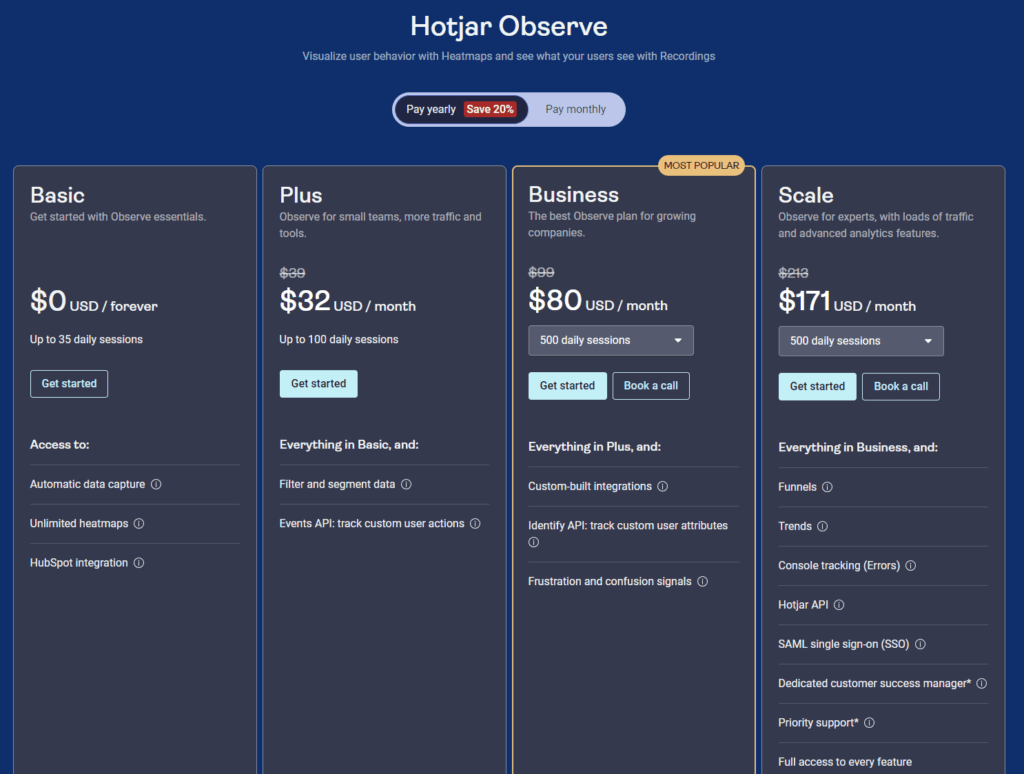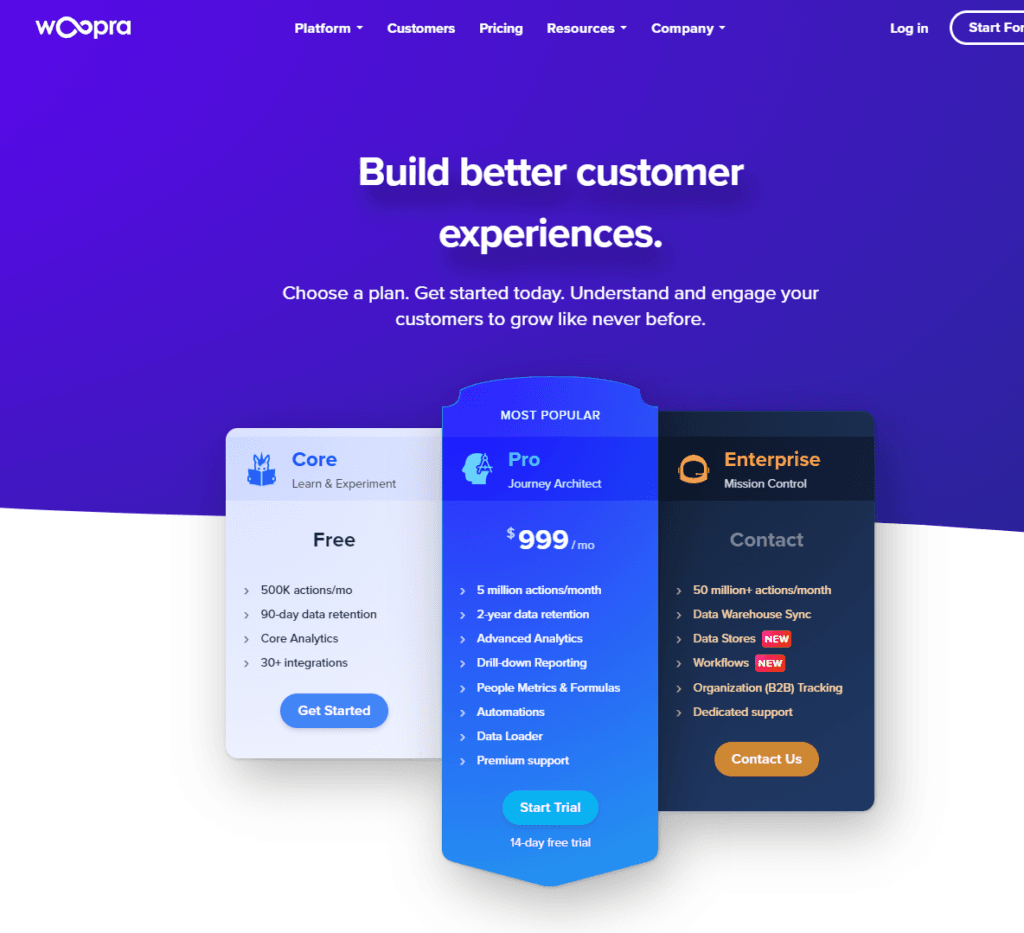In the digital era, understanding user behavior is not just an advantage—it’s essential. But with a sea of analytics tools available, choosing the right one can be daunting. Enter Hotjar and Woopra, two titans in the analytics world, each with unique strengths and approaches to deciphering digital footprints. Hotjar offers a deep dive into user behavior with intuitive heatmaps and session recordings, while Woopra focuses on individual user tracking and real-time analytics to deliver personalized customer experiences. If you’re wrestling with which tool will best illuminate the path to data-driven success for your business, you’re in the right place. Let’s explore what sets these platforms apart and how they can transform your approach to analytics.
| Hotjar | Woopra |
|---|---|
 |  |
| G2 Score – 4.3 out of 5 stars | G2 Score – 4.4 out of 5 stars |
| TrustRadius Score – 8.2/10 | TrustRadius Score – 5.8/10 |
User Behavior Analysis
Understanding the Why Behind the Click
Hotjar: Visualizing the User Journey
Hotjar’s strength in user behavior analysis lies in its suite of visual tools that make complex user interactions understandable at a glance. Heatmaps reveal where users click, move, and scroll, providing a color-coded map of user activity that highlights areas of high engagement and potential points of friction. This immediate visual feedback is invaluable for identifying usability issues or opportunities for optimization without wading through dense data tables.
Session recordings offer a narrative of the user journey, capturing mouse movements, clicks, and page navigation. Watching these recordings feels like looking over the user’s shoulder, offering insights into user behavior that numbers alone can’t convey. This allows teams to empathize with the user, understanding their frustrations and delights in a tangible way.
Feedback tools, including polls and surveys, complement these visual insights by adding a qualitative dimension. They give users a voice, allowing them to articulate their experiences, frustrations, and suggestions for improvement. This direct line to user feedback is crucial for validating quantitative data and grounding decisions in actual user needs and preferences.
Woopra: Tracking Every User Interaction
Woopra approaches user behavior analysis with a focus on individual user journeys across all touchpoints. It tracks a wide array of user actions, from website visits to interactions with emails and support tickets, stitching together a comprehensive view of the customer journey. This end-to-end tracking enables businesses to understand how each interaction contributes to the overall customer experience and identify touchpoints that drive engagement or lead to churn.
Custom event tracking is a powerful feature of Woopra, allowing businesses to define specific actions that are critical to their operations and customer lifecycle. This customization enables a granular analysis of user behavior that is directly aligned with business goals, such as completing a purchase or signing up for a newsletter.
Real-time analytics amplify the value of Woopra’s user behavior analysis, providing instant insights into how changes to the digital environment or marketing strategies affect user actions. This immediacy is key for agile businesses looking to quickly adapt their strategies in response to user behavior trends.
Integration Capabilities and Ecosystem Compatibility
Hotjar: Streamlining User Insights Within Your Digital Toolkit
Hotjar’s approach to integration is designed to enhance its core offerings of visual user insights and feedback collection by ensuring these capabilities can be easily incorporated into a business’s existing digital ecosystem. It accomplishes this through straightforward integrations with a wide variety of content management systems, e-commerce platforms, and marketing tools. This compatibility allows businesses to quickly deploy Hotjar and begin gathering user behavior data without the need for extensive technical adjustments.
Moreover, Hotjar’s ability to integrate with broader analytics platforms, such as Google Analytics, empowers businesses to enrich their quantitative data with qualitative insights directly from their users. This creates a more holistic view of the user experience, bridging the gap between what users are doing on a site and why they are doing it. Such integration capabilities are essential for businesses looking to apply a comprehensive approach to website optimization and user experience enhancement.
Woopra: Creating a Unified View of the Customer Journey
Woopra offers deep integration capabilities, focusing on the unification of customer data from across all points of interaction. By connecting with CRM systems, email marketing platforms, customer support tools, and more, Woopra provides businesses with a 360-degree view of the customer journey. This extensive integration network is foundational to Woopra’s value proposition, enabling the platform to track and analyze customer behavior across a diverse array of touchpoints in real-time.
The platform’s API further extends its integration capabilities, allowing for custom connections that can tailor the data flow to specific business needs. This level of flexibility ensures that Woopra can act as the central hub of a business’s analytics ecosystem, synthesizing data from multiple sources into actionable customer insights. For businesses with complex customer interaction models or those operating across multiple digital platforms, Woopra’s integration strengths offer the comprehensive data consolidation needed to inform personalized engagement strategies.
Data Privacy and Compliance
Navigating the Regulatory Landscape
Hotjar: Championing User Privacy Through Design
Hotjar has built its platform with a keen focus on respecting user privacy while providing valuable insights into website user behavior. It adheres to major data protection regulations, including GDPR in Europe and CCPA in California, offering tools and settings that ensure businesses can collect user insights in a compliant manner. Hotjar allows for the anonymization of personally identifiable information in heatmaps, recordings, and feedback polls, ensuring that businesses can gather data without compromising user privacy.
Furthermore, Hotjar provides comprehensive guidance on configuring settings to meet privacy requirements and on obtaining necessary user consents. This dedication to privacy extends to its data storage and processing practices, which are designed to secure user data against unauthorized access and breaches. By prioritizing transparency and user control over data, Hotjar empowers businesses to build trust with their audience while benefiting from deep user insights.
Woopra: Ensuring Comprehensive Data Control for Compliance
Woopra approaches data privacy and compliance by offering granular control over data collection and processing. Recognizing the varied privacy laws across regions, Woopra enables businesses to customize data tracking and retention policies to align with specific legal requirements. This level of control is critical for businesses operating in multiple jurisdictions, allowing them to adapt their analytics practices to each region’s privacy standards.
Woopra’s commitment to data protection is evident in its features that support compliance with GDPR and other privacy regulations. These include tools for managing user data requests, such as access, rectification, and deletion, which are fundamental rights under GDPR. Woopra’s infrastructure and data management practices are designed to safeguard data integrity and confidentiality, ensuring that customer data is protected throughout its lifecycle.

Related: Check out our free SEO suite

Customer Support and Community Engagement
Enhancing User Experience
Hotjar: A Focus on Accessibility and Community
Hotjar is renowned for its accessible customer support and vibrant community. The platform offers various channels for support, including a comprehensive knowledge base filled with articles that guide users through setup, troubleshooting, and optimization using Hotjar. For more direct assistance, Hotjar provides support via email, where users can expect detailed and helpful responses to their queries.
Beyond traditional support channels, Hotjar has cultivated a robust community of users. Through forums and social media groups, users can connect to share insights, tips, and strategies for leveraging Hotjar to enhance website user experience. This community engagement is a testament to Hotjar’s commitment to not just providing a tool but fostering a space where users can learn from each other and grow together. Additionally, Hotjar encourages user feedback, which it actively uses to inform product development, ensuring that the platform evolves in line with user needs.
Woopra: Tailored Support for Data-Driven Businesses
Woopra distinguishes itself with customer support that caters to the nuanced needs of businesses focused on comprehensive customer analytics. The platform offers an extensive documentation library, detailed tutorials, and resources designed to help users maximize their use of Woopra. For personalized support, Woopra provides assistance through email and live chat, ensuring users can resolve their issues promptly and efficiently.
Woopra also engages with its user community through professional webinars, workshops, and case studies that not only highlight best practices but also showcase real-world applications of Woopra’s analytics. This approach to community engagement positions Woopra as not just a tool provider but as a partner in users’ analytics journeys. The emphasis on professional development through shared knowledge helps users not only in understanding Woopra but in gaining broader insights into customer analytics and data-driven decision-making.
Customization and Flexibility
Tailoring Analytics to Fit Your Needs
Hotjar: User-Centric Customization
Hotjar’s platform is designed with a strong focus on user experience, offering customization options that allow businesses to gather insights tailored to their specific needs. The tool’s heatmaps, for instance, can be customized to track interactions on particular pages or across different devices, providing a nuanced understanding of user behavior where it matters most. Similarly, feedback polls and surveys can be finely tuned, with businesses able to set triggers based on user behavior or specific pages, ensuring that feedback is contextually relevant.
Moreover, Hotjar’s session recordings can be filtered based on various criteria, such as device type or visitor country, allowing businesses to focus on segments of their audience that are most pertinent to their analysis. This level of customization ensures that businesses can zero in on the user experience insights that are most actionable for them, making Hotjar a flexible tool for optimizing website performance and engagement.
Woopra: Custom Analytics for Comprehensive Insights
Woopra offers a high degree of customization and flexibility, particularly in how it tracks and analyzes customer journeys across touchpoints. The platform allows businesses to define their own customer actions and events, creating a customized analytics framework that mirrors their unique operational model and customer journey. This capability is pivotal for businesses looking to understand nuanced customer behaviors and patterns that span across websites, apps, emails, and more.
In addition to custom event tracking, Woopra’s dashboards and reports are highly customizable, enabling businesses to create personalized views of their data that align with specific goals or departments. The flexibility to segment data based on a wide range of criteria further enhances Woopra’s utility, providing detailed insights into different customer segments or behaviors. For businesses with complex customer interactions and multiple digital touchpoints, Woopra’s customization capabilities offer the flexibility needed to gain comprehensive, actionable insights.
Pricing
Hotjar

Woopra

Conclusion
Hotjar shines as a powerful tool for businesses focused on optimizing the user experience on their websites. With its intuitive visualization tools, user feedback mechanisms, and emphasis on privacy and ease of use, Hotjar is ideally suited for teams looking to quickly and effectively understand and improve how users interact with their digital presence.
Woopra, on the other hand, offers a comprehensive view of the customer journey, integrating data across multiple touchpoints to provide businesses with deep insights into customer behavior. Its strength lies in its ability to track individual customer interactions in real-time, offering a level of detail and customization that supports personalized marketing efforts and data-driven decision-making.
Read Next:
- How AI is Changing SEO for Healthcare Websites
- Measuring the Impact of Social Media on Healthcare SEO
- Social Media Meta Tags for Healthcare SEO
- How to Use Pinterest for Healthcare SEO
- 31+ Top Social Media Management tools Compared! (2023)






















Comments are closed.